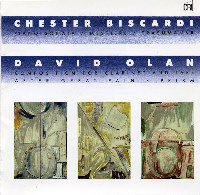Media : Listen
The New Jersey Percussion Ensemble; Gary Van Dyke, conductor
This work appears on Chester Biscardi & David Olan, CRI CD 565 (New York, 1988) along with Piano Sonata (1986; rev. 1987), and Mestiere (1979), Anthony de Mare, piano, as well as three works by David Olan: Composition for Clarinet and Tape (1976), Laura Flax, clarinet; After Great Pain, for soprano and electronic sounds (1982), Judith Bettina, soprano; Prism, for six percussionists and tape (1978), The New Jersey Percussion Ensemble, Peter Jarvis, conductor. Liner notes by the composer.
The piano, which introduces the basic motivic, harmonic, and rhythmic ideas, functions less as a solo instrument than as a means to unify and give motion to a music which varies between being static and highly dynamic. The relationship of the piano to the percussion ensemble was suggested by works for piano and electronic sounds: the percussion functions as an electronic tape – extending, amplifying, and interacting with the sounds of the piano.
“Trasumanar” is a word coined by Dante to describe the experience of rising above the human state. At the beginning of the Paradiso, Dante’s human nature is transmuted to a higher level. He is left bewildered by the sensual pull of being human and the spiritual aspiration to transcend human experience. The dramatic tension created by this struggle provides the structural framework of Trasumanar.
Trasumanar was written for The New Jersey Percussion Ensemble and its director, Raymond DesRoches, with invaluable assistance from percussionist Joseph Passaro.

